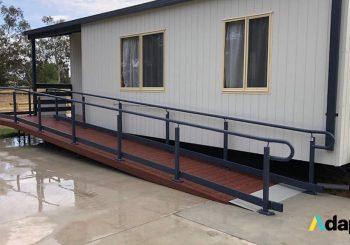Wheelchair ramps are excellent features for those dealing with disabilities, providing them better access to buildings, homes, and offices.
This, in turn, increases both freedom and independence for mobility device users. Although a power wheelchair does require a little practice to manoeuvre, once you get the hang of it, you’d be able to operate it with ease.
Safety is the most crucial aspect to consider while using a wheelchair ramp. You should avoid using ramps that have an incline higher than what you’re comfortable with. Even though you may have some assistance, you shouldn’t disregard your safety.
Learning To Safely Climb a Wheelchair Ramp
Here are a few critical steps to follow while climbing a wheelchair ramp:
- You must remove anything that can cause your wheelchair to tip backwards. For instance, take off your backpack or walker.
- Tighten your seat belt, and ensure that your anti-tip feature is functioning.
- Your next step is to place the wheelchair at the base of the ramp.
- It would help if you concentrated on moving forward. This is one aspect that will slowly improve after some experimentation. Work on developing a technique that’s comfortable yet effective.
Descending Techniques While Using Wheelchair Ramps
Gravity affects the chair, which makes it crucial that you’re vigilant while descending it. Here are a few steps you should follow:
- Tighten your seat belt and make sure that your wheelchair is centred. Power up the chair and move forward slowly.
- You can also consider using a chest strap to stabilise your upper body, as it will prevent you from leaning forward.
- Once you approach the landing area, reduce the speed of your chair and come to a stop.
Additional Safety Tips for Wheelchair Ramp Users
- You can start practicing over ramps that are set on various incline levels.
- Consider using the assistance of a caregiver until you’re capable of handling the ramp by yourself.
Choose the Perfect Disability Ramps for Your Property
Regardless of what many believe, wheelchair ramps are a lot more than a piece of metal. Designing these ramps involves using several different materials, features, slopes, and lengths, and each one of these parts has a purpose. Opt for a ramp that suits your requirements perfectly.
Ramp Construction: The Features
Aspects like the layout of your property, your specific needs, available space, as well as your budget have to be taken into consideration while you’re getting a new ramp installed. Here is some information on the layout of wheelchair ramps that you may find useful. Although wood is the most popular material used for ramps, aluminium is a lot stronger and much more durable.
For maintaining the efficiency of your ramp, the turns, the design, and the width of the ramp has to be perfect. Besides, the corners and angles have to be wide enough to ensure proper manoeuvrability. The only way you can get this right is by determining the width of the wheelchair and then designing the layout based on it.
While designing your ramp, you must keep some additional space for an attendant. Sharp turns can result in severe accidents, which makes it essential to ensure that they’re not incorporated in the design. Before making a final decision, you must consult with experts like the ones at Adapta about the kind of disability ramp you want installed.
We offer a wide variety of ramp layouts and options. We will help you with the design, planning, and the installation of your ramp. You can call 1800 232 782 or contact Adapta through this form, and one of our representatives will contact you shortly.



